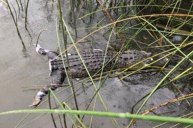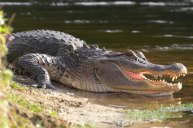Remember those urban legends about alligators living in the sewers? Well, it turns out there's some truth to them after all. A bombshell new study suggests that alligators really do live in the sewers to an extent.
In fact, researchers suggest they use sewer systems as an underground highway of sorts to get to different regions and areas. Basically, they use the underground sewers and drain pipes to travel unimpeded.
"It's like something out of Teenage Mutant Ninja Turtles. The abundance of animals down there was surprising," said Alan Ivory, a PhD student at the University of Florida and researcher in the study, published in Urban Naturalist.
Alligators In The Sewer
It's worth noting that the study is centered around Florida and the Gainesville area. So those New York gators may still be tall tales. Researchers installed 39 motion-activated cameras around the sewer system in Gainsville. For 60 days, they monitored the system in the city.
"We would have raccoons steal cameras every now and then. They would climb up the ladders and tear them off the manholes," Ivory added.
Researchers documented seven species of reptiles moving along the sewer system. But alligators were "documented across the greatest number of sites."
"Of the 5 sites, 4 of the sites where alligators were observed were simple culverts, and for this reason most of the alligator observations were of animals swimming from one pond to another (35 of 50 observations), thereby avoiding crossing busy roads," scientists wrote.
Beyond alligators, researchers observed other species of animals using the storm drains and sewer system. The researcher said, "In total, we documented 3798 animal detections and recorded 35 unique vertebrate species, including 12 species of birds, four species of amphibians, seven species of reptiles, and 12 species of mammals."
Researchers observed 35 different species at the storm drain openings. However, they observed 21 animals including alligators inside of the stormwater system itself. Other species included nine species of birds, reptiles, mammals, and also an amphibian as a well.




